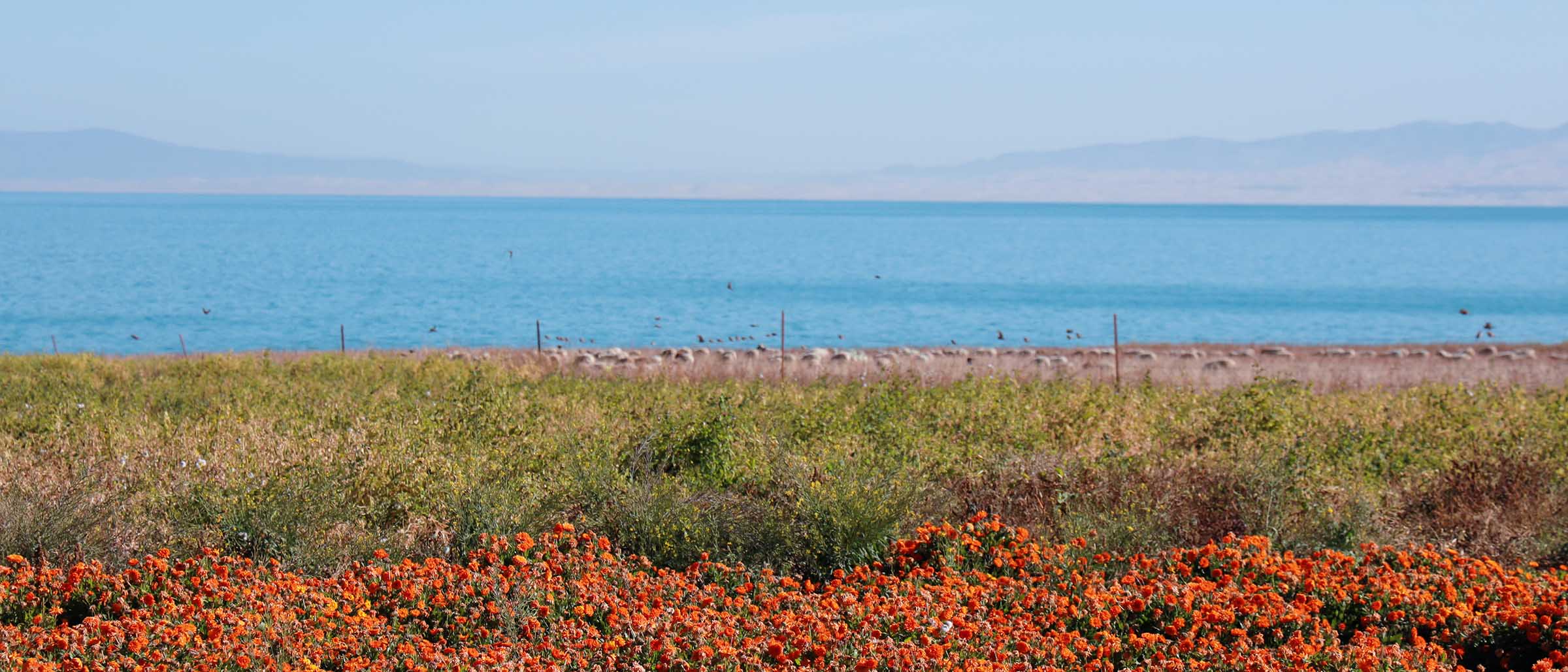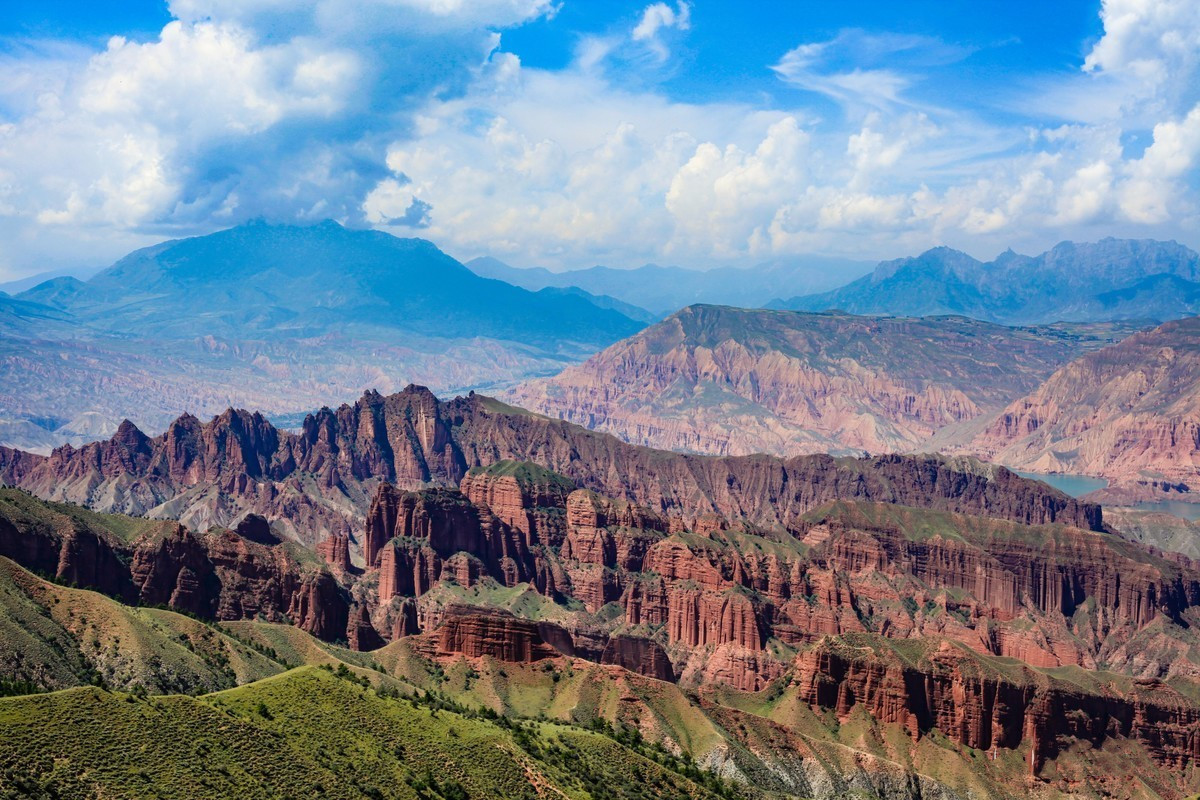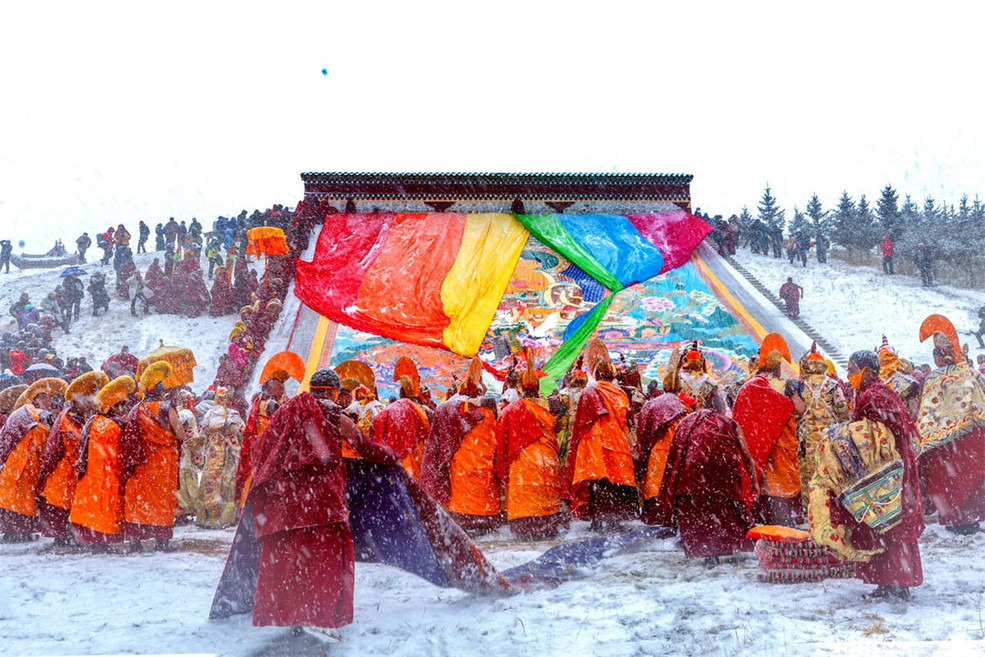- Qinghai -
Qinghai is one of the important province on China's Qinghai-Tibet Plateau. The Chinese name "Qinghai" is after Qinghai Lake, the largest lake in China. Located in the northwest region in China, Qinghai borders on Gansu , Sichaun , Tibet and Xinjiang provinces. It is the source of Chinese two largest rivers Yangtze River and Yellow River; and it is also the birthplace of the Lancang River. It is known as the "source of rivers" and "Chinese water tower".Qinghai is world-renown because of the Qinghai-Tibet Railway, Qinghai-Tibet Road, the southern route of Silk Road, and the Tang-Tibet Ancient Road as well as the Marco Polo Line. They all go through here.

Basic Information
Chinese Name: 青海(Qing Hai)
Location: Qinghai borders Gansu on the northeast, Xinjiang on the northwest, Sichuan on the southeast and the Tibet Autonomous Region on the southwest.
Provincial Capital: Xining
Area: 720thousand square kilometers, Qinghai is the largest province in the People's Republic of China (excluding the autonomous regions).
Population: The total population of Qinghai is 5.78 million.
Average Altitude: 3,000 meters.
Major Ethnic Groups: Zhuang, Hui, Mongolian
Famous City: Xining, Delingha, Golmud.
Qinghai Geography
Qinghai is located on the northeastern part of the Tibetan Plateau. The Yellow River originates in the southern part of the province, while the Yangtze and Mekong have their sources in the southwestern part. Qinghai is separated by the Riyue Mountain into pastoral and agricultural zones in the west and east.
By area, Qinghai is the largest province in the People's Republic of China. Qinghai Lake is the largest salt water lake in China, and the second largest in the world. The Qaidam basin lies in the northwest part of the province. About a third of this resource rich basin is desert. The basin has an altitude between 3000 and 3500 meters.
The Sanjiangyuan National Nature Reserve, is located in Qinghai and contains the headwaters of the Yellow River, Yangtze River, and Mekong River. The reserve was established to protect the headwaters of these three rivers and consists of 18 subareas, each containing three zones which are managed with differing degrees of strictness.
Qinghai Climate
The average elevation of Qinghai is over 3,000 metres above sea level.Mountain ranges include the Tanggula Mountains and Kunlun Mountains, with the highest point being Bukadaban Feng at 6,860 metres. Qinghai forms a distinctive plateau continental climate because of the interactions of the factors, such as, its elevation, its terrain, its latitude, its geographic location, atmospheric circulation, etc. It is long but not cold in winter, short and cool in summer, and four seasons change obscurely. Its mean annual temperature is approximately −5 to 8 °C, with January temperatures ranging from −18 to −7 °C and July temperatures ranging from 15 to 21 °C . It is also prone to heavy winds as well as sandstorms from February to April. Significant rainfall occurs mainly in summer, while precipitation is very low in winter and spring, and is generally low enough to keep much of the province semi-arid or arid.
Tourism Resources
Located on the northeastern part of the Tibetan Plateau, Qinghai is a province in China surrounded by Gansu Province on the north and east, Xinjiang Province on the west, Tibet on the south and Sichuan on the southeast. It is named after Qinghai Lake, the largest saltwater lake in China.
Qinghai now has 11 world-class scenic spots, 79 national-level spots, as well as hundreds of provincial-level scenic spots. More than 400 tourism resources have developing prospects, and quite a lot of them can be describe as China’s, and even world’s, greatest attraction. The most representative landscapes such as Qinghai Lake, the Three River source Region, the Qilian Mountain grassland, the clear Yellow River, as well as the Kunlun Mountains Culture, the Kumbum Monastery, Liu Wan’s Colorfully Painted Pottery, and local ethnic custom parks allow one to appreciate the Tibetan, Mongolian ans Salar folk culture, etc.
Qinghai is relatively unknown to foreign travelers. This huge area is home to many Tibetan monasteries, vast grasslands, the headwaters of the three of Asia largest rivers - the Yellow River, the Yangtze River and Mekong River. It also boasts of a mosaic of ethnic groups, including Tibetan, Mongols, Tu, Goloks and Hui with a vibrant religious life.
For foreign travelers, Qinghai is one of the frontiers of adventure travel in China, a springboard for China' wildest travel for Lhasa by rail, Yushu by road, Gansu and Labrang Monastery by road, and further westward the ancient silk road to Xinjiang.
Qinghai Culture and Religion
Located mostly on the Tibetan Plateau, the province has long been a melting pot for a number of ethnic groups including the Han, Tibetans, Hui, Tu, Mongols and Salars. Tibetans constitute a fifth of the population of Qinghai and the Hui compose roughly a sixth of the population. There are over 37 recognized ethnic groups among Qinghai's population of 5.2 million, with national minorities making up a total of 45.5% of the population.The predominant religions in Qinghai are Chinese folk religions(including Taoist traditions and Confucianism) and Chinese Buddhism among the Han-Chinese. The large Tibetan population practices Tibetan schools of Buddhism or traditional Tibetan Bön religion, while the Hui-Chinese practice Islam. It is also a culturally intersection place where diversified cultures join together; including the Yangtze River, the Yellow River, the Indian civilization, the Islamic civilization, along with some ancient Greek culture and ancient Roman culture, which all originated here.
Qinghai Cuisine
Qinghai attracts tourists from all over the world, not only for its spectacular landscapes but also for its distinctive food culture. Each cuisine contains rich ethic specialties. People crave a gourmet month- watering snack.
Qinghai is one of the four major pastoral regions in China. Every herdsman here is a skillful cook. They specialize in cooking beef and mutton with a great look and taste. It is one of the traditional local delicious. Qinghai’s special drink, Tianpei-Sweet fermented barley, is made of highland barley with a sweet and refreshing taste which is quite similar to fermented glutinous rice wine. Gamianpian Noodles is a typical food for common Qinghai household. It can comes with or without soup. Stewing or boiling or stir-frieing, each cooking method turns out an unique taste.
There are also other kinds of delicious snakes like Fazi ( raft-shaped sausage), Naipi( a kind of cheese), Sanzi(fried noodle), Mashi(Pasta in soup), Assorted nuts and fruits, Niangpi (thin wheaten sheet), Steamed Beef Rendon, Braised Lamb Meat and so on.
Folk Festivals
Nadam Fair
Nadam means “entertainment” or “games” in Mongolian language. Nadam Fair is a Mongolian annual traditional festival, especially popular in Inner Mongolia, Gansu, Qinghai and Xinjiang. It contains traditional but popular Mongolian sports, such as wresting, horse racing, archery contests, Bulu racing, lassoing horses and Mongolian chess. In some places, some competitive events such as track and field events, tug-of-war, volleyball and basketball matches are also held. During the grand fair, people enjoy performances of martial arts, polo, archery on horseback, swordsmanship on horseback, a horse-walking race, as well as a motorcycle race. In the horse-walking event, the participating horses are all well trained and their four hooves are not allowed to leave the ground at the same time during the race. Nadam Fair is held every year in July and August, when there are rich rainfall, lush grasslands, flourishing livestock, fine weather and fresh air.
Corban Festival
Corban means “sacrifice”, and is a major Islamic rite to show obedience and faith to Allah. Corban Festival, or Eid al Adha, is one of the major Islamic festivals celebrated by Muslims in Qinghai. It is also called the Loyalty and Filial Piety Festival among Chinese Muslims. Corban Festival falls on the 10th day of the 12th month in the Islamic calendar, and is the last day of pilgrimage activities. On that day, Muslims speaking Chinese, Turkish and other languages gather at mosques in splendid attire to celebrate the festival. After the ceremony, people in good financial condition will butcher a cow or sheep and split the meat into three parts: one for the poor, one for relatives and one for themselves.
Horse Racing Festival
Horse-racing is a major sport in Qinghai, and is very popular in Beishan (Ledu County), which is part of Xunhua, and pasturing areas across and province. There are two kinds of horse races: one judges the rider for his speed and footwork skill while the other judges the rider only for speed. To win the race, the rider must be good at selecting, raising and training his horse, last but not least, the horse-racing, which is the climax of the whole event. Some spectators will present colorful silk scarfs, called Hada or Khata, to the winner, and friends, relatives and female family members will hang embroidered bags on the horse’s mane. The winning horse is colorfully decorated with the largest number of embroidered bags.
Hua’er Festival
On the sixth day of the sixth lunar month, people across Qinghai celebrate this colorful event, and the one held in the scenic area of Laoye Mountain in Datong, 36 kilometers away from Xining, the capital of Qinghai Province, is the most famous. That day, people gather on the mountain to sing “Hua’er” songs (folk songs of love in Qinghai) in groups divided by ages. Singing “Hua’er” songs is a way for local people to express their love and the Hua’er Festival offers them an opportunity to find love, express love and sing love songs. Many good folk singers stand out in the singing contests.
Kanbula National Forest Park
Chinese name: 坎布拉森林公园(Kan Bu La Sen Lin Gong Yuan)
Location: Northwest of Jiancha County, Huangnan Tibetan Prefecture, Qinghai Province.
Ticket: Entrance ticket CNY50.00, sightseeing bus CNY100.00, Lijiaxia cruise CNY100.00
Estimated tour time:4-6 hours
Recommended time to visit: May-Oct
Nearby attractions: Guide National Geological Park, Xiaqiong Monastery, Qinghai Lake.

With a total area of 4,774 hectares, Kanbula National Forest Park is located in Huangnan Tibetan Autonomous Prefecture in rural Kanbula Jianzha County, 200 km from Xining in Qinghai Province. With an altitude of 2,100 to 4,000 meters above sea level, it borders on the Yellow River in the north, abutting against the famous Lijiaxia Hydroelectric Power Station.
There are eighteen perilous peaks in the Kanbula Region. Two of them, the A’qiongnanzong and the Neibaozong, are the most famous. The A’qiongnanzong is surrounded by steep cliffs. There is only one path with stone steps, through which people can get to the top of the peak. The major portion of the path is cut out of the cliffs. At the top of the peak stand an ancient Buddhist temple and several small caves. Many Buddha statues are displayed in the caves. A great number of people come to here all the year around. The Neibaozong is a square separated peak. There are a lot rare plants on the peak. At the top of it, there are the Sky Pond and spring. Birds sing and flowers bloom on tree-covered slope. Gurgling streams flow along the valley accompanying the tranquil hollow. In a word, it's an enchanting landscape.
There are deflated hills formed in the northwest of Qaidam Basin for the long-term erosion of wind and sand, which are called red-cloud landforms. The unique Kanbula red-cloud landforms are mainly featured by wonderful peaks, high mountains, caves, precipitous cliffs and many rock peaks, stone columns and stone walls in shapes. The large mountains look like grand and vertical column, tower or castle; the small hills look like giant and strange animal of odd shapes. Meeting of Fairies, “Qiangqi Hill” and “Nanzong Valley” are the most representatives of the landforms in various appreciable shapes.

For a fantastic perspective on the park and its simply beautiful greens, purples, sapphires and blues of the mountains, waters and sky over Kanbula, climb the long wooden steps up to the vast Big Buddha – a huge and unfinished peak-top statue at the end of the stairs.
The Kanbula area is famous for its unique Danxia landform. Here, the mountain is tall and straight, forceful and magnificent, full of the masculinity, giving out a strong natural scenery charm; which is believed to be the national most. This area is also the birthplace of the Houhong period of Tibetan Buddhism with rich cultural connotation.
The religious cultures have a long history in the area of Kanbula, Here is the home of Ahqiong Nanzong Temple, Nanzong Buddhist Nunnery, Zanzongzha Temple and Gabu Temple, all of which have a history more than 1,100 years. Nanzong Temple and Nanzong Buddhist Nunnery are the only religious Buddhist places with monks and nuns coexist with each other in Qinghai Province China.
Lijiaxia Gorge
Lijia Gorge is more than 30 kilometers in length. The project of this station is April 1988; and the successful closure of this station is on October 13, 1991. This hydropower station has vast water level and good water quality. The dam reservoir area along with the forest park, form a comprehensive large sightseeing district, one of the most spectacular gorges of the Yellow River’s hydropower systems.
More than 30 kilometers in length, the Lijia Gorge ends at the dam with its hydropower station, from where the yellow River continues its course eastward. One of China’s amazing feats of structural engineering, the dam channels thousands of gallons of water each day through its channels, creating massive amounts of power for the surrounding areas.

Lijia Gorge reservoirs belong to the second step hydropower stations in upper Yellow River within the territory of the famous Kanbula National Forest Park, Running through the Kanbula national Forest Park, the gorge is surrounded by bright red Danxia rock formations, a stark contrast to the azure blue of the deep waters in the gorge.
The artificial lake in the reservoir area covers an area of 32 square kilometers. The lake water is dark green, which is an ideal location to develop aquaculture industry. During summer and spring, tourists can white water rafting and angle for fish in the lake. While in winter and spring, tourists have the chance to enjoy the sight of snowscape on the plateau, which adds a proper highland human landscape to the beautiful and old Kanbula Scenic Area. Go upstream along the reservoir area by ship, you can visit the Centre Island and Songba Gorge.

- $1198.00
- 9D8N DAYS
01. Monlam Festival (or The Great Prayer Festival) is the grandest religious festival in Tibet, the 10-Day Amdo Tibetan Monlam Festival tour offers you an opportunity to attend festival events with thousands of local Tibetan nomads, you can …
Read More
- $948.00
- 7D6N DAYS
1. Kanbula National Park: Gazing out across some of the most sublime mountain and river panoramas in the land, Stunning landscapes of Danxia Red Peaks and forest, lakes, Tibetan pastures, valley and monasteries on the peaks.2. Qinghai Lake :…
Read More